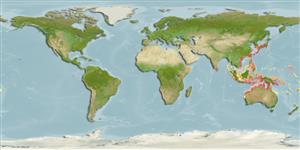Environment: milieu / climate zone / depth range / distribution range
पारिस्थितिकी
समुद्री प्रवाल-भित्ति संयुक्त; गहराई सीमा 8 - 25 m (Ref. 54394). Temperate
Northwest Pacific: endemic to East Asian continental shelf.
आकार / वज़न / Age
Maturity: Lm ? range ? - ? cm
Max length : 19.0 cm TL पुल्लिंग / अलिंग; (Ref. 3131)
पृष्ठीय रीढ़ (सम्पूर्ण) : 8; पृष्ठीय सौफट रेज़ (सम्पूर्ण) : 8; गुदा कांटा: 3; ऐनल सौफट रेज़: 5; जानवरों की रीड़ का जोड़: 26. Diagnosis: The underside of mandible has numerous tiny pores, no ridges. Preocular spine usually divided into 2 points, and flattened anteriorly and posteriorly. There are no additional spines between lacrimal and suborbital ridges. Upper opercular spine usually simple, tip pointed. Midinterorbital space moderately deep, not covered with scales. Interorbital ridge indistinct. Pored lateral-line scales 32-36 (mode 32). Longitudinal scale rows 47-56 (49). Scale rows between last dorsal-fin spine origin and lateral line 4\.2-5\.2 (5). Pectoral-fin rays 19-21 (20). Posterior margin of maxilla not reaching a vertical at posterior margin of pupil. Pectoral fin long (2.7-3.1, mean 2.8 in SL), reaching or extending beyond a vertical at origin of last dorsal-fin spine. Interorbital width wide (5.4-7.9, 6.7 in HL). Membrane anterior to sixth dorsal-fin spine extending up to 51-63% (57%) of the spine length. First anal-fin spine 1.2-1.5 (1.3) in third spine. Second pelvic-fin soft ray 1.5-1.8 (1.7) in HL. Bilobed portion of swim bladder more than half of total swim bladder length. Color of head and body blackish in preserved specimens; body, head, and pelvic and anal fins orange when fresh; no distinct small black spots on head or lateral line (Ref. 54394).
Inhabits rocky reefs with sandy substrata. Depth extension 25-30 for underwater photographs taken off Izu Peninsula and a single specimen reported to be collected from Okinawa Trough at 205 meters (Ref. 54394). Anterolateral glandular groove with venom gland (Ref. 57406).
Life cycle and mating behavior
परिपक्व अवधि | पुनरुत्पत्ति | मछलीऔ का अंडे देना | अंडे | Fecundity | लार्वा
Motomura, H., 2003. Revision of the scorpionfish genus Neosebastes (Scorpaeniformes: Neosebastidae), with descriptions of five new species. Indo-Pac. Fish. (37):46 p. (Ref. 54394)
IUCN Red List Status (Ref. 130435: Version 2024-1)
Human uses
साधन
Special reports
Download XML
इंटरनेट स्रोत
Estimates based on models
Preferred temperature (Ref.
123201): 20 - 28.2, mean 26.9 °C (based on 637 cells).
Phylogenetic diversity index (Ref.
82804): PD
50 = 0.5002 [Uniqueness, from 0.5 = low to 2.0 = high].
Bayesian length-weight: a=0.01995 (0.00906 - 0.04395), b=3.01 (2.83 - 3.19), in cm total length, based on all LWR estimates for this body shape (Ref.
93245).
Trophic level (Ref.
69278): 3.6 ±0.4 se; based on size and trophs of closest relatives
Fishing Vulnerability (Ref.
59153): Low vulnerability (10 of 100).
